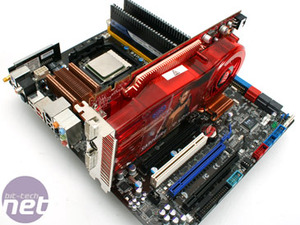Conclusions & Value
The 2.2GHz Phenom 9500 is around £150-£160 (inc. VAT), 2.3GHz 9600 is £176-£180 (inc. VAT) and the 2.4GHz 9700 Phenom is... not yet available. Considering that the Intel Core 2 Quad Q6600 can be bought for around £160 (inc. VAT) there's very little reason to buy a Phenom for a new system at the moment.The problem is, and the thing that scares me is that the Intel Core 2 Quad Q6700 is a massive price jump. Why? Because Intel can: there is no competition coming from AMD above the Q6600 so you have to pay the premium. As consumers no matter how much we love blue, green or red, we absolutely need AMD to make a good product to keep prices reasonable.
The Agena core makes great use of some high performance computing (HPC) applications but not others - video encoding like DivX or MPEG4-AVC work well, but 3D rendering however doesn't work quite as well. Unfortunately, most HPC workstation users will be more interested in the latter, I fear. A couple of Opterons strung together via HyperTransport is still the best way to do things in a multi-processor environment, but on the consumer side of things where programmes are still predominantly single threaded it looks particularly weak.
However, despite the fact we cannot recommend the Phenom to consumer users, without AMD competing in some form or other, our worst fear might be realised and we will have to pay through the nose for the high-end performance we all desire. What exacerbates these fears is the potential future niche market that Intel is creating for enthusiasts with Nehalem, and that the completely new execution architecture in Fusion is coming in 2009 at the earliest (we all know what AMD schedules are like).
To make matters even worse, consider AMD's financial position - it'll never go out of business, but if it decides to concentrate on its strengths this could leave desktop users further out in the cold. AMD (ATI) has fantastic power regulation technology, as demonstrated in its chipsets, graphics products and to some extent, its CPUs, and it's looking to bring all that to mobile devices as soon as possible. Since both mobile and HPC applications are considered the future and where the money will be, this could certainly end up being where most of their resources are heading.
Let's not forget the other aspects of the recent Spider launch though; the 790FX/790X/770 chipsets are all very low power and generally great value, even if it does still have only the antiquated SB600. The Radeon HD 3870 was recently given a recommended award by us and AMD's OverDrive shows real potential as well, so it's not all doom and gloom for AMD.
Final Thoughts
The bottom line is that AMD's Phenom processors are currently too expensive and don't perform well enough to offer serious competition for Intel's quad-core processors. With the low clock speeds, AMD needs applications that make use of multiple cores to show off the benefits but, as most real consumer applications are single threaded (or maybe occasionally dual-core optimised), there aren't any real benefits to Phenom in its current state.The situation has completely reversed from back in the day when it was Intel's Pentium 4 versus AMD's Athlon 64 -- AMD's Phenom processors are outperformed almost right across the board, and this is especially the case in gaming and single-threaded tests where the processors lack raw MegaHertz. That said, I almost hope consumers will buy them, just to make sure that there's still a market left for us enthusiasts in the future.
- Performance
- x
- x
- x
- x
- x
- x
- -
- -
- -
- -
- 6/10
- Value
- x
- x
- x
- x
- x
- x
- x
- -
- -
- -
- 7/10
- Overall
- x
- x
- x
- x
- x
- x
- -
- -
- -
- -
- 6/10

MSI MPG Velox 100R Chassis Review
October 14 2021 | 15:04











Want to comment? Please log in.